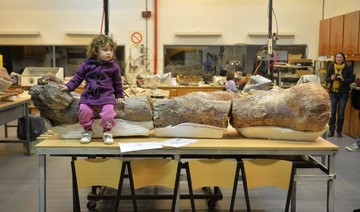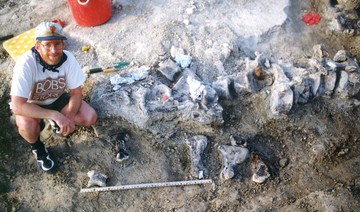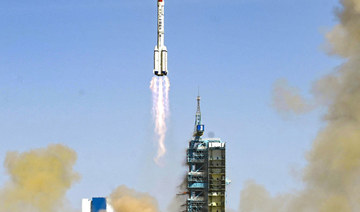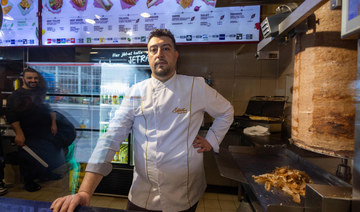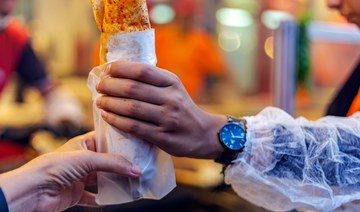YANJI, China: At the end of a street of newly built high-rises in the northern Chinese city of Yanji stands an exposed cliff face, where paleontologists scrape away 100 million-year-old rock in search of prehistoric bones.
Like many fossil excavation sites in China, this one was discovered by accident.
China’s rapid city building has churned up a motherlode of dinosaur fossils. While bulldozers have unearthed prehistoric sites in many countries, the scale and speed of China’s urbanization is unprecedented, according to the United Nations Development Program.
Perhaps no one has seized the scientific opportunity more than Xu Xing, a diligent and unassuming standard-bearer for China’s new prominence in paleontology. The energetic researcher has named more dinosaur species than any living paleontologist, racing between dig sites to collect specimens and further scientists’ understanding of how birds evolved from dinosaurs.
Matthew Lamanna, a curator at the Carnegie Museum of Natural History in Pittsburgh, said Xu is “widely regarded as one of the foremost, if not the foremost, dinosaur paleontologist working in China today.”
“Xu Xing is A-M-A-Z-I-N-G,” Kristina Curry Rogers, a paleontologist at Macalester College in St. Paul, Minnesota, wrote in an email.
Two years ago, Xu’s colleague at the Chinese Academy of Sciences in Beijing, Jin Changzhu, was visiting family in Yanji when he heard talk of fossils uncovered at a construction site. A preliminary inspection yielded what appeared to be a dinosaur shoulder bone.
Less than an hour’s drive from the North Korean border, the midsize city has been erecting residential blocks quickly. Seen from a plane, Yanji looks like a Legoland of new pink- and blue-roofed buildings, but there’s one long empty lot of exposed rocky hillside — the excavation site.
When Xu arrived at Yanji, he recognized the site could fill gaps in the fossil record, noting the relative paucity of bones recovered from the late Cretaceous period, which was around 100 million years ago. An analysis of the layers of volcanic ash revealed the site’s age. Xu is now overseeing a team of scientists using picks, chisels and steel needles to study the exposed hillside, where geologic layers resemble a red and gray layer-cake.
The site has yielded partial skeletons of three ancient crocodiles and one sauropod, the giant plant-eating dinosaurs that included some of the world’s largest land animals.
“This is a major feature of paleontology here in China — lots of construction really helps the scientists to find new fossils,” said Xu as he used a needle to remove debris from a partially exposed crocodile skull.
Born in 1969 in China’s western Xinjiang region, Xu did not choose to study dinosaurs. Like most university students of his era, he was assigned a major. His love for the field grew in graduate school in the 1990s, as feathered dinosaurs recovered from ancient Chinese lakebeds drew global attention.
When Xu and Jin discovered fossils in Yanji in 2016, city authorities halted construction on adjacent high-rise buildings, in accordance with a national law.
“The developer was really not happy with me,” said Xu, but the local government has since embraced its newfound claim to fame.
The city is now facilitating Xu’s work, and even built an on-site police station to guard the fossils from theft. Once the excavation is complete, a museum is planned, to display recovered fossils and photos of Xu’s team at work.
It’s not the first museum to commemorate Xu, whose prodigious fieldwork has taken him across China and resulted in a flurry of articles in top scientific journals.
Toru Sekiyu, a paleontologist from the Fukui Prefectural Dinosaur Museum in Japan who assisted on the Yanji dig, called his Chinese colleague “a superstar paleontologist.”
But Xu is quick to point out the role that good fortune has played in his career.
“To publish papers and discover new species, you need new data — you need new fossils,” he said, adding that finding new species isn’t something a scientist can plan.
“My experience tells me that you really need luck, besides your hard work. Then you can make some important discoveries.”
With digs in Inner Mongolia, Liaoning, Yunnan and other Chinese provinces, Xu patiently oversees excavations, sometimes chiseling for years before he knows their ultimate significance.
While his finds are wide-ranging, much of his career has focused on understanding how dinosaurs evolved into modern birds.
China is an ideal location for that study. Two decades ago, rare dinosaur fossils that preserved traces of feathers were found in ancient lakebeds of northeastern China. This discovery, which helped scientists demonstrate that birds descended from dinosaurs, was possible because the mixture of volcanic ash and fine-grained shale in the lakebeds had preserved bits of soft tissue, including feathers — unlike the majority of dinosaur fossils, which contain only bone.
Since then, a flood of new dinosaur bones unearthed in China has helped scientists rewrite their understanding of the tree of life in various ways.
Xu has been at the forefront of research into how dinosaurs evolved feathers and flight. In 2000, he described a curious pigeon-sized dinosaur with four feathered limbs, apparently early wings that allowed the animal to either fly or glide. In 2012, he detailed a carnivorous tyrannosaur , which also had plumage — raising questions about feathers’ original purpose.
Xu now believes that early dinosaur plumage may have played a role in insulation and in mating displays, even before flight feathers evolved. He co-authored a 2010 paper that examined fossilized melanosomes — pigment packets that give rise to color in modern bird feathers — to deduce the likely colors of dinosaur feathers. Some species likely sported rings of white and brown tail feathers; others had bright red plumage on their heads.
Embracing new technology, his team also uses CT scanners to study the interior of fossils and builds 3-D computer simulations to make inferences about what range of motions a dinosaur may have had.
One of the fossils Xu is now examining, found at a construction site in Jiangxi province, will shed light on how modern birds’ reproductive systems evolved from dinosaurs, he says.
In addition to professional accolades, Xu’s work has attracted attention from schoolchildren in multiple countries, who mail him handwritten notes and crayon drawings of dinosaurs, several of which hang in his Beijing office.
Xu replies to every letter, email and text message with a question about dinosaurs. “I feel it would be weird or impolite not to,” he said. But in an era of social media, Xu has refrained from signing up for WeChat, the dominant messaging platform in China, because “I don’t think I could find time for all the new messages.”
Back at the site in Yanji, a colleague brings him a large rock with an exposed sauropod vertebrae to examine.
The bone has a spongey texture, which Xu says is a result of the animal’s respiratory system. Like modern birds, he believes sauropods breathed using both lungs and distributed air sacs, which can leave an impression in the bones.
Xu uses a brush to flick away dirt to inspect the fossil more closely.
“Basically we are reconstructing the evolutionary tree of life,” he said. “If you have more species to study, you have more branches on that tree, more information about the history of life on Earth.”
China building boom uncovers buried dinosaurs, makes a star
China building boom uncovers buried dinosaurs, makes a star
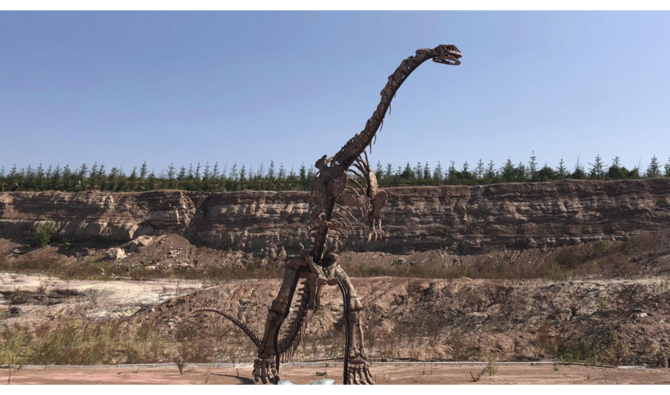
- China’s rapid city building has churned up a motherlode of dinosaur fossils
French barber still trimming at 90
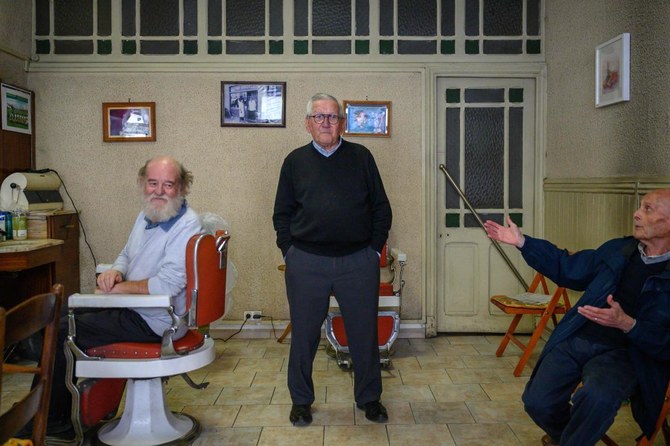
- “I love this job, it’s in my bones,” he said
- Even with arthritis, he is on his feet from Tuesday to Saturday, tending to his customers’ hair and beards in his shop in the small southern town of Saint-Girons
SAINT-GIRONS, France: French barber Roger Amilhastre, 90, could have hung up his clippers decades ago but he said his passion for hair gives him a reason to get up in the morning.
“I love this job, it’s in my bones,” he said, leaning on one of his cast-iron barber’s chairs from the 1940s.
“And despite my age, my hands still don’t shake.”
Even with arthritis, he is on his feet from Tuesday to Saturday, tending to his customers’ hair and beards in his shop in the small southern town of Saint-Girons in the foothills of the Pyrenees.
“I would have liked to retire at 60, but my wife was sick and I needed to pay for the care home,” he said, which cost more than 2,000 euros ($2,150) a month.
Even after his wife died in January, he kept going to work to stave off the sad thoughts.
“I’m not grumpy getting up” to go to work, he said.
France’s national hairdressers’ union believes Amilhastre may be France’s oldest active barber.
“We have a few who continue late in life, but 90 years old is exceptional,” union president Christophe Dore told AFP.
“I’m not sure if he is France’s oldest barber, but if not, he can’t be far off,” he added.
According to the national statistics institute INSEE, a little more than half a million people over 65 still work in France.
In the southern region of Occitanie, where Amilhastre lives, only 1.65 percent of people older than 70 years old still work, including 190 79-year-olds. But statistics do not go beyond that age.
Many of Amilhastre’s customers call him Achille, after his father who founded the barber’s shop in 1932, giving it his name and then teaching his son the profession.
The shop witnessed the German occupation of France during World War II.
“During the war, German police came to find my father to groom a captain who had broken his leg,” Amilhastre said.
German troops had taken over a large stately home in town called Beauregard.
“We were scared because they used to say that anyone who went up to Beauregard never came back,” he said.
“Luckily he did.”
The 90-year-old said he remembered a “tough period” for businesses when he first picked up the scissors in 1947 a few years after the war ended.
But then the town rebounded, he said, with its men following a flurry of new hair trends from greased back quiffs in the 1950s to 1970s bowl cuts.
The barber’s shop survived an economic downturn as local paper mills closed in the 1980s sparking mass layoffs, and supermarkets pushed small shops out of business.
“People started looking for work further afield, so we had to adapt and stay open later in the evening,” Amilhastre said.
That same decade, the AIDS epidemic sent customers into a worried frenzy.
“People were scared. They no longer asked to be shaved and when we did, we were petrified there’d be a cut, that someone would bleed and the virus would be passed on to the next customer,” he said.
Jean-Louis Surre, 67, runs the nearby cafe where Amilhastre once taught him to play billiards as a young boy.
Behind his bar, Surre said he still remembered his mother taking him across the road to see Amilhastre for a haircut every month as a child.
“He’d pump up the chair to reach the mirror, use his clippers and then at the end perfume you with some cologne — you know, squeezing those little pumps,” he said.
He is one of several old-timers to regularly drop by Achille’s — even just to read the newspaper or have a chat.
Inside the barber’s, Jean Laffitte, a balding 84-year-old, said he no longer really needed a haircut.
“With what little is left up there, these days I come out of friendship,” he said.
China’s Shenzhou-18 mission docks with space station

- The astronauts took off from the Jiuquan Satellite Launch Center in China’s northwest at 8:59 p.m. local time Thursday
- The astronauts will stay at the Tiangong space station for six months, carrying out experiments
JIUQUAN, China: A spaceship carrying three astronauts from China’s Shenzhou-18 mission safely docked at Tiangong space station Friday, state-run media reported, the latest step in Beijing’s space program that aims to send astronauts to the Moon by 2030.
The crew took off in a capsule atop a Long March-2F rocket from the Jiuquan Satellite Launch Center in China’s northwest at 8:59 p.m. local time 1259 GMT) Thursday.
By early Friday the spacecraft had “successfully docked” with the space station, state-run news agency Xinhua reported, citing the China Manned Space Agency.
The mission is led by Ye Guangfu, a fighter pilot and astronaut who was previously part of the Shenzhou-13 crew in 2021.
He is joined by astronauts Li Cong and Li Guangsu, who are heading into space for the first time.

Onlookers cheered as the rocket blasted off into the night sky, an AFP journalist at the scene said.
Xinhua said the launch had been declared a “complete success.”
The astronauts will stay at the Tiangong space station for six months.
There they plan to carry out experiments “in the fields of basic physics in microgravity, space material science, space life science, space medicine and space technology,” the China Manned Space Agency has said.
They will also try and create an aquarium onboard and seek to raise fish in zero gravity, according to Xinhua.
“Not only will the taikonauts find joy in the space ‘aquarium,’ but it may also pave the way for their future counterparts to enjoy nutritious fish from their own in-orbit harvests,” it added.
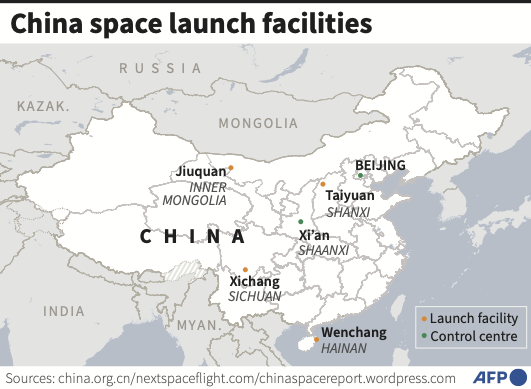
They will also conduct experiments on “fruit flies and mice,” a researcher quoted by the agency said.
The new crew will replace the Shenzhou-17 team, who were sent to the station in October.
Plans for China’s “space dream” have been put into overdrive under President Xi Jinping.
The world’s second-largest economy has pumped billions of dollars into its military-run space program in an effort to catch up with the United States and Russia.
Beijing also aims to send a crewed mission to the Moon by 2030, and plans to build a base on the lunar surface.
China has been effectively excluded from the International Space Station since 2011, when the United States banned NASA from engaging with the country — pushing Beijing to develop its own orbital outpost.
That station is the Tiangong, which means “heavenly palace” — the crown jewel of a space program that has landed robotic rovers on Mars and the Moon, and made China the third country to independently put humans in orbit.
It is constantly crewed by rotating teams of three astronauts, with construction completed in 2022.
The Tiangong is expected to remain in low Earth orbit at between 400 and 450 kilometers (250 and 280 miles) above the planet for at least 10 years.
Algeria’s first KFC restaurant reopens without logo following Gaza protests
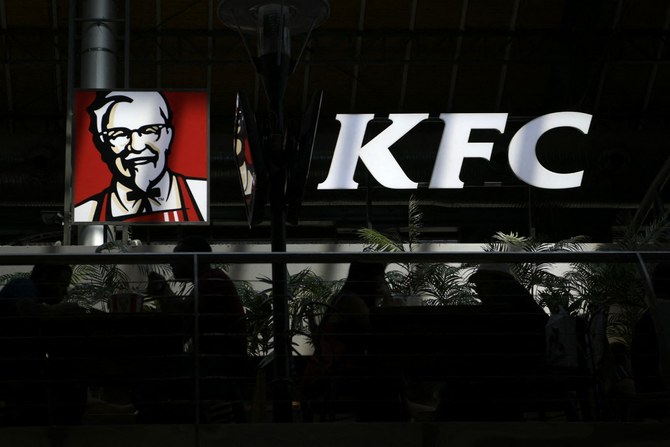
- Protesters gathered outside outlet last week in solidarity with Palestinians
- KFC parent company Yum! Brands has faced backlash for its ties with Israel
LONDON: Algeria’s first Kentucky Fried Chicken outlet has resumed operations after a temporary closure prompted by a series of pro-Palestinian demonstrations last week.
However, the restaurant, situated in the Algiers suburb of Dely Ibrahim, reopened its doors without the familiar Col. Sanders logo on its exterior.
It remains unclear if the outlet has had a change of ownership or remains under the umbrella of Yum! Brands, the parent company of KFC.
Demonstrators gathered outside the eatery on April 16, calling for a boycott and expressing solidarity with Palestinians amid the Gaza conflict.
Protesters draped in Palestinian flags voiced support for “Palestinian martyrs” while obstructing access to the storefront.
The restaurant has faced a backlash due to its perceived ties to Israel, with Yum! Brands having made investments in Israeli startups, including TicTuk, a company that allows customers to order food on social networks and message apps, and Dragontail, a system software company specializing in food processing.
In response, the Boycott, Divestment, Sanctions movement designated KFC’s sister company, Pizza Hut, as an “organic boycott target,” due to the “brands’ complicity in Israel’s genocide and apartheid against Palestinians.”
بعد أيام من افتتاح فرعها الأول، KFC الجزائر تزيل شعار علامتها وتُغلق أبوابها!
— أحمد داود (@AhmadDaoud14) April 17, 2024
منذ افتتاحها تعالت أصوات مقاطعتها، ووقفات احتجاجية أمامها، واستنكارٌ لمنح الترخيص لوكيلها! #الجزائر
pic.twitter.com/rIaOG80xTi
While the temporary closure of the KFC outlet was hailed as a success by demonstrators, its reopening sparked disappointment among some Algerians.
The incident underscores challenges and employment ramifications stemming from boycotts related to the Gaza conflict.
Since the start of the war, regional franchises of McDonald’s, one of the key boycotted brands, have distanced themselves from the parent company, arguing that they are 100 percent local.
The opening of a KFC branch in Algeria was noteworthy given the nation’s historical aversion to Western food chains, as well as its stringent foreign investment regulations, which typically prohibit the establishment of foreign food or beverage franchises.
Previous efforts to establish outlets without official approval, such as the brief appearance of a counterfeit “Starbucks,” have been met with swift action and closure.
Doner diplomacy: German president’s kebab trip to Turkiye sparks controversy
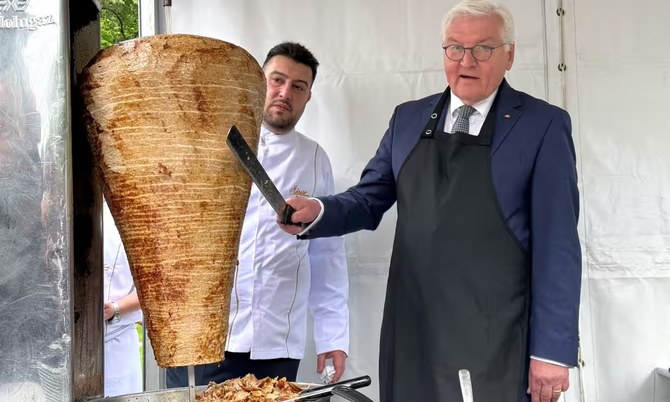
- German-Turkish say 60-kg kebab skewer brought from Germany in diplomatic mission reduces community’s contributions to stereotypical image
LONDON: German President Frank-Walter Steinmeier’s visit to Turkiye this week has stirred controversy after he brought along a 60-kg kebab skewer as part of his diplomatic mission.
Starting his three-day tour in Istanbul instead of Ankara, Steinmeier served kebabs at a reception, viewing it as a symbol of cultural exchange between the two nations.
“It is these special and intense relationships that bridge distances, and also some differences, today,” he said.
However, rather than emphasizing the close personal ties between Germans and Turks, the gesture drew criticism from many in the diaspora who viewed it as reducing their community’s contributions to a stereotypical image.
Germany, home to 2.7 million people of Turkish descent, welcomed hundreds of thousands of workers in the 1960s as part of its “guest worker” program, a bilateral agreement with Ankara to address labor shortages.
Turkish-Germans took to social media to condemn what they saw as a clumsy attempt to represent their community, accusing Steinmeier of failing to take them seriously or treat them as equals.
“Turkish-Germans discovered the 1st COVID vaccine in the world; some were movie directors who won awards on behalf of Germany, numerous writers, musicians, intellectuals from Turkey call Germany home,” wrote Evren Celik Wiltse, a professor of political science, on X.
“Of all of these, the (German) president chose the kebab maker to accompany him to (Turkiye)”, she added.
Turkish-Germans discovered the 1st COVID vaccine in the world; some were movie directors who won awards on behalf of Germany, numerous writers, musicians, intellectuals from Turkey call Germany home.
— Evren Celik Wiltse (@EvrenWiltse) April 22, 2024
Of all these, the president chose the kebab maker to accompany him to https://t.co/ZVMHyi48P0
Berkay Mandıracı, a senior analyst of Turkish-German heritage at the non-governmental organization Crisis Group, acknowledged that the gesture was well-intentioned but felt it was “anachronistic and reductionist.”
A well-intended gesture, I'm sure, but somehow not belonging to this age. As someone born and raised (until I was 12) in Germany, this feels anachronistic and reductionist.
— Berkay Mandıracı (@BerkayMANDIRACI) April 23, 2024
But let's not read too much into it and hope the rest of the visit will deepen Turkish-German ties https://t.co/ZjUvCLH7ES
The faux pas, which risked overshadowing the celebration of 100 years of diplomatic ties between the two nations, received the approval of Arif Keles, a third-generation kebab shop owner invited on the delegation trip by Steinmeier.
Keles, who served kebabs during the reception, described the opportunity as a “great honor.”
The dish of thinly sliced meat cooked on a vertical rotisserie was introduced to Germany by Turkish migrants.
Packed with chopped vegetables and doused with mayonnaise, the doner kebab has gained iconic status.
Local sales of the kebab total an estimated €7 billion ($7.5 billion), an immigrant success story the German presidency wanted to celebrate as an example of “how much Turkiye and Germany have grown together.”
Relations between Berlin and Ankara have been strained by various disputes, including disagreements over the Gaza conflict.
Steinmeier, visiting Turkiye for the first time since assuming office in 2017, has had a challenging relationship with Turkish President Recep Tayyip Erdogan, criticizing him for his approach to concerns about democratic norms in Turkiye.
Turkish-Germans have long spoken up about economic and social exclusion. Last year, Germany agreed to significantly ease citizenship rules to allow more dual nationals, a move welcomed by many Turkish individuals who have lived in Germany for decades.
With AFP
Controversy erupts as British MP Lee Anderson misses St. George’s Middle Eastern heritage

- The politician fails to acknowledge the patron saint of England’s connection to the Middle East in a video posted to celebrate St. George’s Day
LONDON: Reform UK MP Lee Anderson faced mockery after failing to acknowledge St. George’s historical ties to the Middle East in a recent social media post.
The former politician, who joined the far-right party after being suspended by the Conservatives for racist remarks about Mayor of London Sadiq Khan, shared a video on Tuesday commemorating St. George’s Day.
In it, Anderson proudly displayed red and white cufflinks matching the English flag. Also known as the St. George’s Cross, the symbol is historically associated with the Christian crusades.
“It’s St. George’s Day today and this country of ours has been a gift to the world,” Anderson said in the video.
In the accompanying caption, he wrote: “Trigger Warning. If you are a Guardian reading, advacado eating, Palestinian flag waving, Eddie Izzard supporting Vegan then this clip is probably not for your consumption.”
Anderson’s comments sparked amusement among users on X, where critics seized on his misspelling of “avocado” and highlighted the connection between Palestine and St. George, who is revered not only in England but also in parts of Africa, the Middle East, the Caucasus, and South America.
Comedian Shaparak Khorsandi quipped: “Who is going to tell him about St George’s connection to Palestine? (His mother was Palestinian, they too have a St. George’s day/feast. Though, to be fair, it is not known if he was related to Eddie Izzard),” referring to the actor/comedian.
Another user responded by sharing an image detailing facts about St. George, suggesting that if he were alive today, he would be considered an “immigrant” by Anderson’s standards, a group the Reform UK MP has repeatedly advocated should be deported.
Happy St George’s day. pic.twitter.com/Zq9cKGksOK
— GonePrivateIsh - still the same drivel (@Lairdysnr) April 23, 2024
Observed annually on the anniversary of St. George’s death with parades and marches, St. George’s Day was previously a national holiday and was once celebrated in England as widely as Christmas.
Born around AD 280 in what is now known as Cappadocia, Turkiye, St. George served as a soldier in the Roman army and fought in the crusade against Muslims. Beheaded in modern-day Palestine for refusing to renounce his Christian faith, St. George is revered by Christians, Druze and some Muslims as a martyr of monotheistic faith.
Renowned for his strength, courage and loyalty, St. George became a cherished figure in Europe and has been a symbol of English culture since the 14th century, despite never setting foot in the country.



